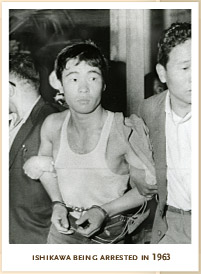The sentence was later commuted to life with hard labor, and confirmed by the Supreme Court in 1977. After 32 years in prison, Ishikawa was released on probation in 1994. Since his conviction, three appeals for retrial have been submitted in an effort to clear his name. The latest, filed on May 23, 2006, offers a rich body of new evidence supporting Ishikawa’s innocence. His defenders remain optimistic that, this time, the courts will deliver Ishikawa a fair and just trial.
The Sayama Case highlights fundamental problems with the Japanese criminal justice system, and makes clear the persistent discriminatory stereotyping of Buraku people. On the heels of the third appeal, IMADR, in solidarity with the Buraku Liberation League and the Citizen’s Support Group for the Sayama Case, has launched the Sayama International Solidarity Campaign to help lobby for change in the criminal justice system and fight anti-Buraku discrimination. Join the struggle against racism in the administration of justice by reading on.
On May 1, 1963, in Sayama City, north of Tokyo, a female high school student disappeared on her way home from school. That evening, a ransom note was delivered to her home. Soon after, the girl’s body was found in a nearby field. After a team of 40 police investigators failed to capture the criminal, the chief of police resigned and media began to scrutinize the case. Under intense public criticism, the police searched a nearby Buraku district on the off chance that they would find the criminal there. On May 23, they arrested Kazuo Ishikawa.
I didn’t learn that I was from a Buraku, or even what that word meant, until after I was sentenced to death.
While I appealed my case, a detention center employee took interest in my case and decided that if I were really innocent, I would need to know how to read and write to be able to fight the court’s decision. With his help, I started to read about Buraku discrimination and realized that I was of Buraku descent. I learned that this was the reason why I was in jail. At about the same time, the Buraku Liberation League got involved in my case. They gave me things to read, about Buraku history and Buraku discrimination, but also about what was going on in the world outside of prison. I started to learn that there was a whole movement out there of people like myself. I had never known this before, and if I hadn’t learned to read and write, I would never have known my own history.
Ishikawa, along with an estimated six million other Japanese, is of Buraku origin. Buraku people are a social minority, ethnically and linguistically indistinguishable from other Japanese. They face discrimination because of an association with work once considered ‘impure’, such as butchering animals. In particular, they often have trouble finding marriage partners or employment. There is also a widely held stereotype that Buraku people are rougher and more violent than other Japanese – a central problem in the Sayama Case.
In addition to the bigotry that led to Ishikawa’s arrest, the Sayama Case highlights more general problems with the Japanese criminal justice system. Detainees can be held by police and prosecutors for up to 23 days before formal charges are laid. During that time, they do not necessarily have access to a lawyer. State-appointed lawyers are only granted, after the first three days in detention, in the case of serious crimes that could lead to life imprisonment or the death sentence (this system was set up very recently, in October 2006).
To make this campaign successful, your help is needed.
Here are some things you can do to make a difference:
